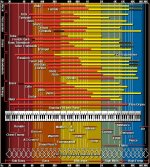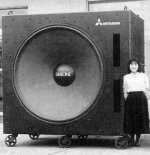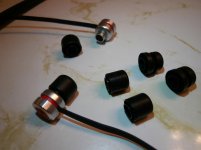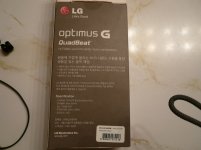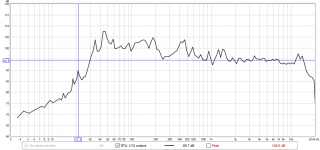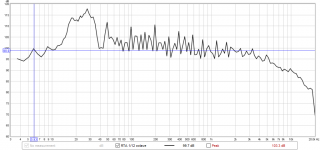I don’t know if we can hear that low, but the fun comes when you can feel it—like in the opening of 2001 (zarathustra)… i remember very well how that felt [emoji7]
Stanley Kubrick was a visionary, according to his film and my interpretation, the extraterrestrial monolith awakened the primates' instinct for power. That part was good too, those timpani are superb, although they don't have harmonics in the sub-bass range, their fundamental starts at 60 Hz.
In the beginning of the movie, I think I get some sub-frequencies, through my AKG 141 headphones connected to my HTPC, although they are not flat either, they do drop - 12 dB from 100 to 20 hz.
45 2001, Odisea en el espacio – Asi hablo Zaratustra de R Strauss - YouTube
Measurement's report AKG K 141 test and graphs - Reference Audio Analyzer
OT 1: It seems that in the end Pete is right, aliens do not exist, because a civilization more evolved than ours should not come to spoil the nap of the monkeys!😉
OT2: Surely many will think that you cannot listen to sub-frequencies with a headset because the wavelength of 20 Hz is 17 meters to complete a cycle, etc, etc. I will not enter into that discussion, I will leave it to the experts, but I would like this question to be definitively clarified.
Go ahead, I'm all ears.😎
Attachments
At wavelengths much longer than head size the eardrum responds to air pressure, not air movement. The wavelength doesn't come into it, at least not until the sound pressure variations have passed through to the cochlea. The placement of a headphone cup over an ear is making a quasi isobaric chamber between the driver and the eardrum.OT2: Surely many will think that you cannot listen to sub-frequencies with a headset because the wavelength of 20 Hz is 17 meters to complete a cycle, etc, etc. I will not enter into that discussion, I will leave it to the experts, but I would like this question to be definitively clarified.
Go ahead, I'm all ears.😎
At wavelengths much longer than head size the eardrum responds to air pressure, not air movement. The wavelength doesn't come into it, at least not until the sound pressure variations have passed through to the cochlea. The placement of a headphone cup over an ear is making a quasi isobaric chamber between the driver and the eardrum.
Thanks, now it is clear to me, and with the help of this attachment, even more !
😉
How Do Headphones Produce Bass Frequencies? | zZounds Music Blog
Think about low end in a car. Its doable but takes more power and hard to make flat.
Ok, i'm thinking about it ...
Well, a closed air chamber, something in between a room and a headset, a car ......
I also always thought that the membrane / magnet ratio of a headphone gives a very high BL within a very small enclosure, - compared to a 21 "subwoofer transducer within a room of, say, 100 m3 - which results in a hyper sensitivity to low frequencies ...
But maybe it doesn't have much to do with it, I have my doubts here ...😕
I stand corrected. 🙂
Well, you should know, 😉 there is no totally flat dynamic transducer, this is due - mainly, there are other factors - because a coil within a magnetic field (gap) is an inductive reactance, the signal generated by it will depend on the position of the same (travel) within that field and then it cannot give a constant voltage signal throughout its entire extension.
If it is not clear, let me know and I will look for documentation. 😀
Your subwoofers are very nice, congratulations !
Thanks for the summary.Well, you should know, 😉
Yes I do actually understand the behavioral characteristics of the vc in the gap.
+/-3db I and the general audio community consider flat for all intents and purposes. When it gets to 4 or 5 I'm not so impressed.
yes they are fabulous. They mesh perfectly with my Acoustats, so very fast and immediate. It sounds like it's all coming from the stats. They don't sound like "subs". They just project the music.
These little isobarics will produce the cleanest, flattest bass you're likely to hear. I believe the FR is very close to perfect. 3 different eq ear inserts. $30.00 + taxAt wavelengths much longer than head size the eardrum responds to air pressure, not air movement. The wavelength doesn't come into it, at least not until the sound pressure variations have passed through to the cochlea. The placement of a headphone cup over an ear is making a quasi isobaric chamber between the driver and the eardrum.
Attachments
Last edited:
.......... When it gets to 4 or 5 I'm not so impressed.
Nothing that cannot be "flattened" with DSP, which would introduce a new topic of debate !
Regarding the statement of the thread, I do not agree at all that to reproduce sub-frequencies it does not matter any speaker ...
The right driver with the right implementation is what it takes. The drivers in the 5150s are not particularly well made. But the box configuration and the drivers are an engineered system, hence the result. Everything is precisely tailored to suit requirements. However I don't see why the same could not be achieved or better with enough attention to detail by diy.Nothing that cannot be "flattened" with DSP, which would introduce a new topic of debate !
Regarding the statement of the thread, I do not agree at all that to reproduce sub-frequencies it does not matter any speaker ...
The speakers of many current prestigious cabinets do not look as they should, but the TS parameters are good and many times requested by the brand.
The "bulk" speaker manufacturers go out of their way to make them look nice, it helps to sell.
I remember many (before TS? When did that start?) Like AMT 1 from Heil, Andromeda from Phase Linear, etc ... they were sad to see them "without the clothes"
The "bulk" speaker manufacturers go out of their way to make them look nice, it helps to sell.
I remember many (before TS? When did that start?) Like AMT 1 from Heil, Andromeda from Phase Linear, etc ... they were sad to see them "without the clothes"
That's true to a certain point, however some beautifully made drivers are also of very high quality in terms of performance. JBL comes to mind, the template of the industry in the beginning, always top notch in every respect. However later on even they began making products to suit particular mass market targets. Now you have drivers in multi-thousand dollar systems made to order with minimum attention to aesthetics. If some of those drivers were an option for a diy project they'd be passed over for something better. 🙂
Stanley Kubrick was a visionary
FWIW/FYI, here's the interactive version of the chart: Interactive Frequency Chart from Independent Recording Network
Interactive hearing chart: Interactive Ear Sensitivity Chart - Independent Recording Network
FWIW/FYI, here's the interactive version of the chart: Interactive Frequency Chart from Independent Recording Network
Unfortunately, the chart does not cover 'electronic' sounds.
Sidebar: For a while now I've increasingly ignored manufacturer's alleged specifications. I've just played this track: Urban Shakedown feat. Micky Finn - "Some Justice' (1991) - YouTube through all of my subs.
My Vector VW8 (28hz) phoned it in.
My pair of LG7's (35hz) produced an impressive combination of purrs and growls inducing other household items to vibrate in sympathy when under duress.
My Audica Pro (40hz) auditioned for a job in the demolition, hitting the certain notes too hard. Fun fact: air from the port was able to sway clothes hanging on a dryer over 6ft away.
Please, will anybody with there system connect to the Internet perform the same test?
I'll take your "Urban Shakedown" (1st picture) and raise with a re-bassed version of Rob Dougan's "Clubbed To Death" that was in circulation many years ago (2nd picture). Notice what's going on below 20 Hz, compared to your track 🙂
I can't seem to find a copy of it online again, so I've uploaded a copy to my website. PM me for link if you want it.
I can't seem to find a copy of it online again, so I've uploaded a copy to my website. PM me for link if you want it.
Attachments
I'll take your "Urban Shakedown" (1st picture) and raise with a re-bassed version of Rob Dougan's "Clubbed To Death" that was in circulation many years ago (2nd picture). Notice what's going on below 20 Hz, compared to your track 🙂
I can't seem to find a copy of it online again, so I've uploaded a copy to my website. PM me for link if you want it.
It wasn't a competition. I'm trying to compare apples to apples. Urban Shakedown is a fairly standard MP3 where I assume everything below 20hz was discarded,
That's true to a certain point, however some beautifully made drivers are also of very high quality in terms of performance. JBL comes to mind, the template of the industry in the beginning, always top notch in every respect. However later on even they began making products to suit particular mass market targets. Now you have drivers in multi-thousand dollar systems made to order with minimum attention to aesthetics. If some of those drivers were an option for a diy project they'd be passed over for something better. 🙂
"That's true up to a point "
Uff...
Where does it contradict what I wrote? It is an addition, in any case. I bought a pair of JBL car speakers, (they were made of tin, and with little ventilation in the back of the cone, something inevitable for it to have rigidity) and when I wanted to install them they did not fit into the original speaker housing because the size of the magnet ceramic was too big. I finally used them to make a MTM / Sealed / Coaxial.
I bet they are unique in the world.
This is DiyAudio!
JBL GTO 627 Compliance ?
Sorry, I have a bit of trouble with your grammar here and there. I misunderstood what you were saying. 🙂
All good, friend. 🙂
The language is sometimes a big stumbling block, sometimes not so much.
For example, no one answered what I wrote - post 30/31 - from the thread that I attached above.
I expected an immediate correction, and there was no response!
A pinch of salt is good from time to time ...
PS: to prevent overheating I used the paint suitable for high temperatures. I believe that 360 degrees Celsius of protection will be enough 😱
The language is sometimes a big stumbling block, sometimes not so much.
For example, no one answered what I wrote - post 30/31 - from the thread that I attached above.
I expected an immediate correction, and there was no response!
A pinch of salt is good from time to time ...
PS: to prevent overheating I used the paint suitable for high temperatures. I believe that 360 degrees Celsius of protection will be enough 😱
Last edited:
- Home
- Loudspeakers
- Subwoofers
- Is 'quality' really that important down there?
